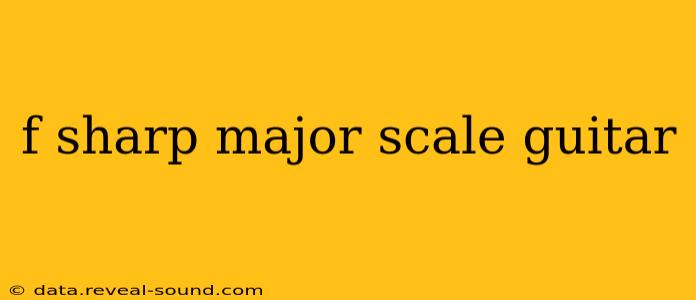The F# major scale is a deceptively challenging yet incredibly rewarding scale to master on the guitar. Its unique intervallic structure and relative minor (G# minor) open up a world of musical possibilities. This guide will break down everything you need to know about playing the F# major scale on guitar, covering various positions, common chord progressions, and helpful practice tips.
F# Major Scale Fingerings on Guitar
The F# major scale consists of the notes F#, G#, A#, B, C#, D#, and E#. There isn't one single "best" fingering; the optimal choice depends on the context (song, riff, solo) and your individual playing style. However, here are a few common and effective fingerings:
1. The "Open" Position (First Position):
This fingering utilizes open strings, making it ideal for beginners and for certain melodic phrasing. It’s not as flexible for fast runs or wider intervals but provides a solid starting point. (Note: Specific fingerings may vary slightly depending on hand size and personal preference).
2. Second Position:
Shifting the scale up the neck opens up access to different voicings and facilitates smoother transitions between higher and lower notes. This position provides a more fluid feel for soloing.
3. Third Position and Beyond:
As you progress, learning additional positions will unlock even more expressive possibilities. Explore moving the same pattern up and down the neck to expand your scale knowledge and fluency. This will significantly increase your comfort and ability to navigate the fretboard.
How to Practice the F# Major Scale Effectively
Effective practice is key to mastering any musical scale. Here’s a structured approach:
- Start Slowly: Focus on accuracy and clean transitions between notes. Speed will come with consistent practice.
- Use a Metronome: This ensures rhythmic precision and helps develop a strong sense of timing. Gradually increase the tempo as your accuracy improves.
- Alternate Picking: Practice both downstrokes and upstrokes evenly to enhance your picking technique.
- Scale Runs: Practice ascending and descending runs in various rhythms.
- Arpeggios: Break down the scale into its constituent chords (F#maj7, G#min7, A#min7, C#7, etc.) and practice arpeggiating them.
- Improvisation: Once comfortable with the scale, start improvising over backing tracks or chord progressions in F# major.
What are the chords in the F# Major scale?
The F# major scale contains the following diatonic chords:
- F# Major: The tonic chord.
- G# minor: The relative minor chord.
- A# minor: A minor chord within the scale.
- C# Major: The dominant chord.
- D# minor: A minor chord within the scale.
- E Major: The major chord of the sixth degree of the scale.
What is the relative minor of F# major?
The relative minor of F# major is G# minor. This means that G# minor shares the same notes as F# major, but begins on G#. Understanding the relative minor opens up additional harmonic possibilities when composing or improvising.
What are some common chord progressions in F# major?
Many common chord progressions can be adapted to the F# major key. Popular choices include:
- I-IV-V-I: F#maj - Bmaj - C#7 - F#maj
- I-vi-IV-V: F#maj - D#min - Bmaj - C#7
- ii-V-I: G#min - C#7 - F#maj
By mastering the F# major scale and exploring its related chords and progressions, you’ll significantly expand your musical vocabulary and unlock new creative potential on the guitar. Remember consistent, focused practice is the key to success!
